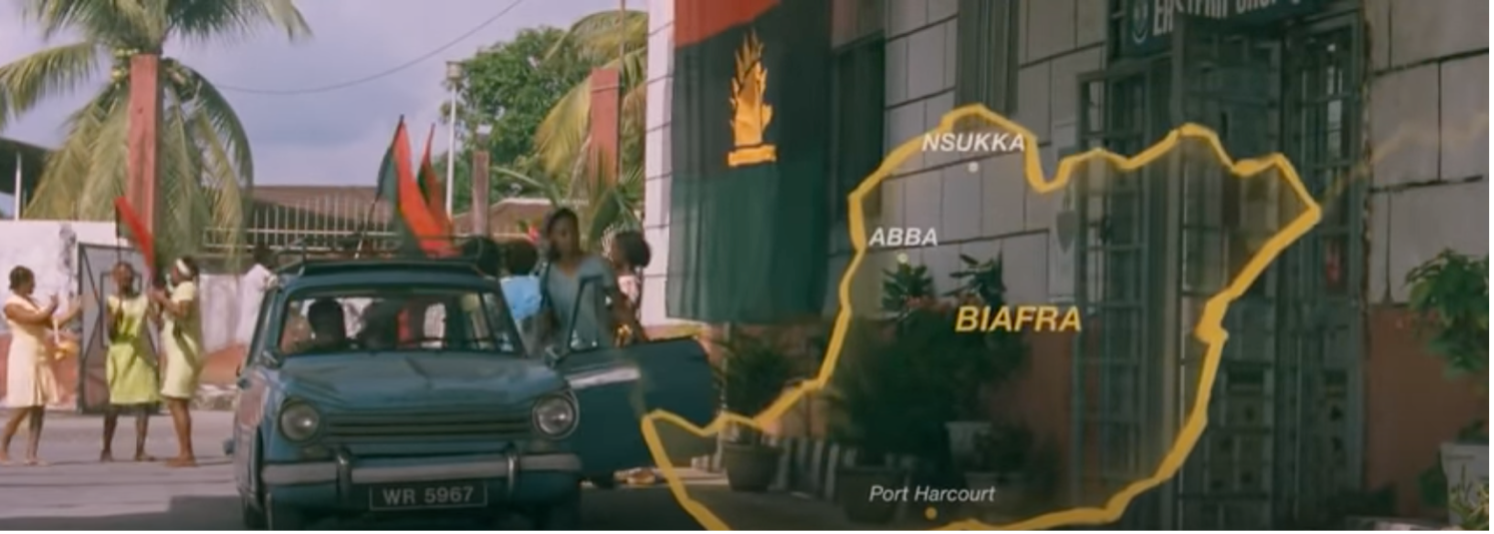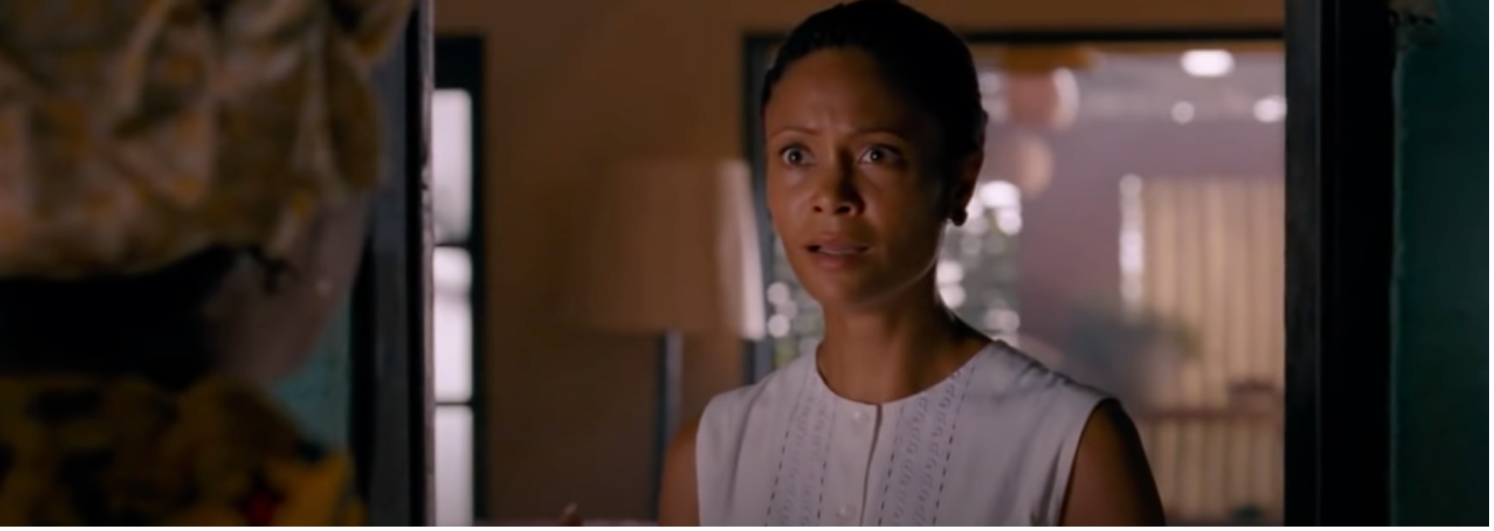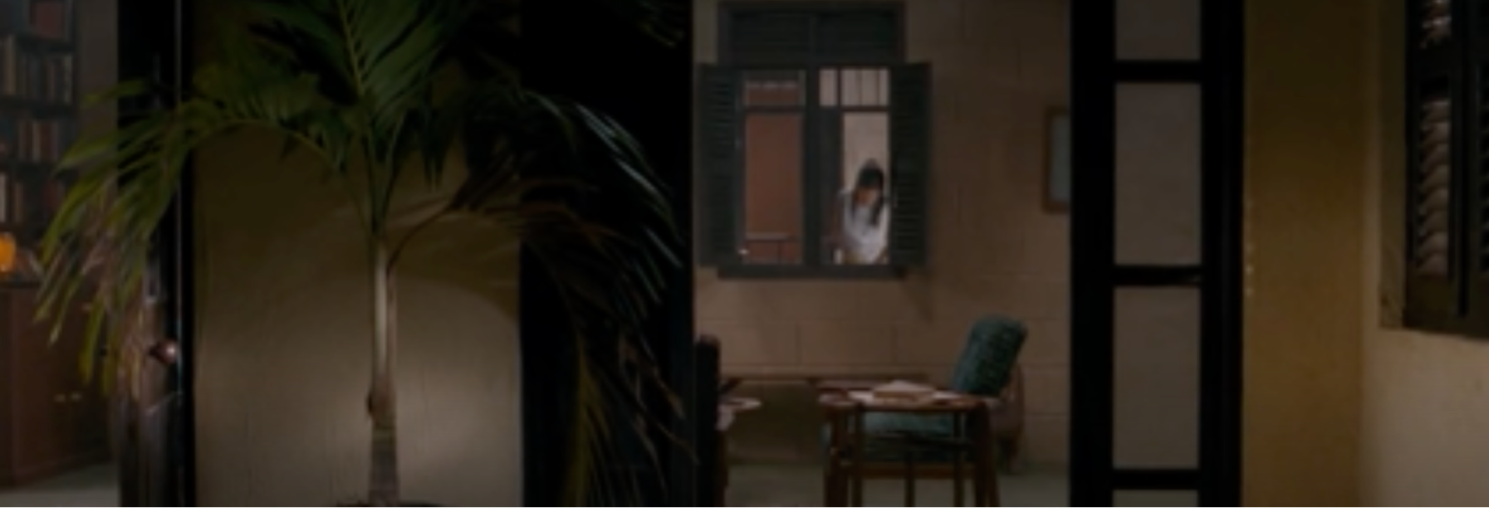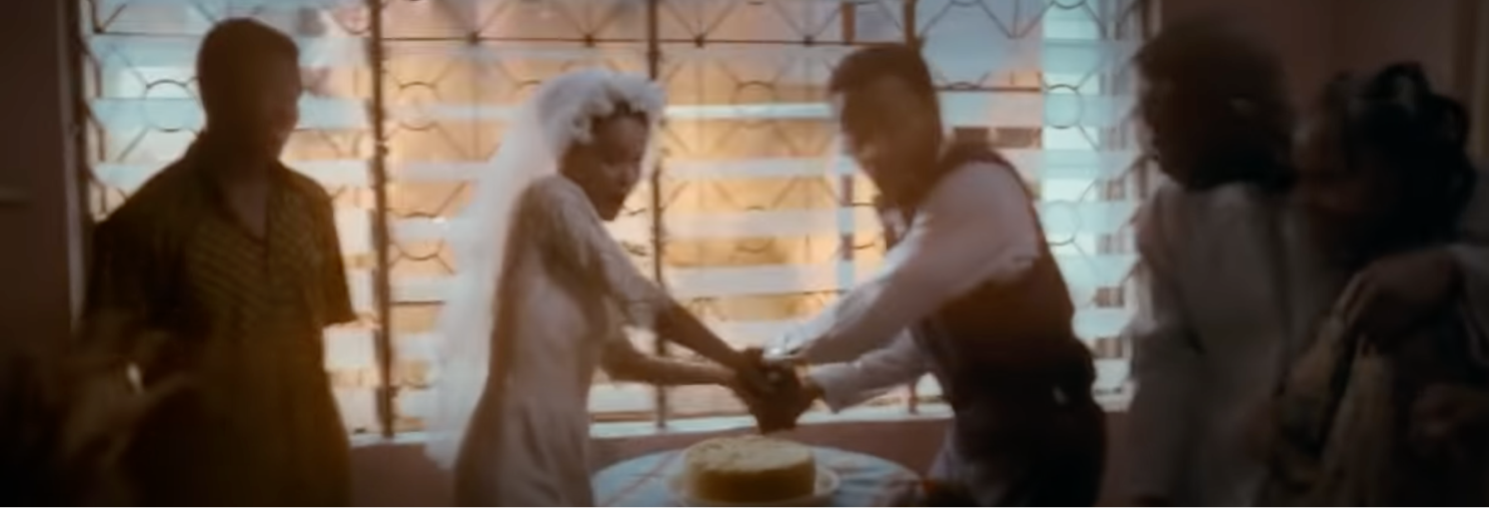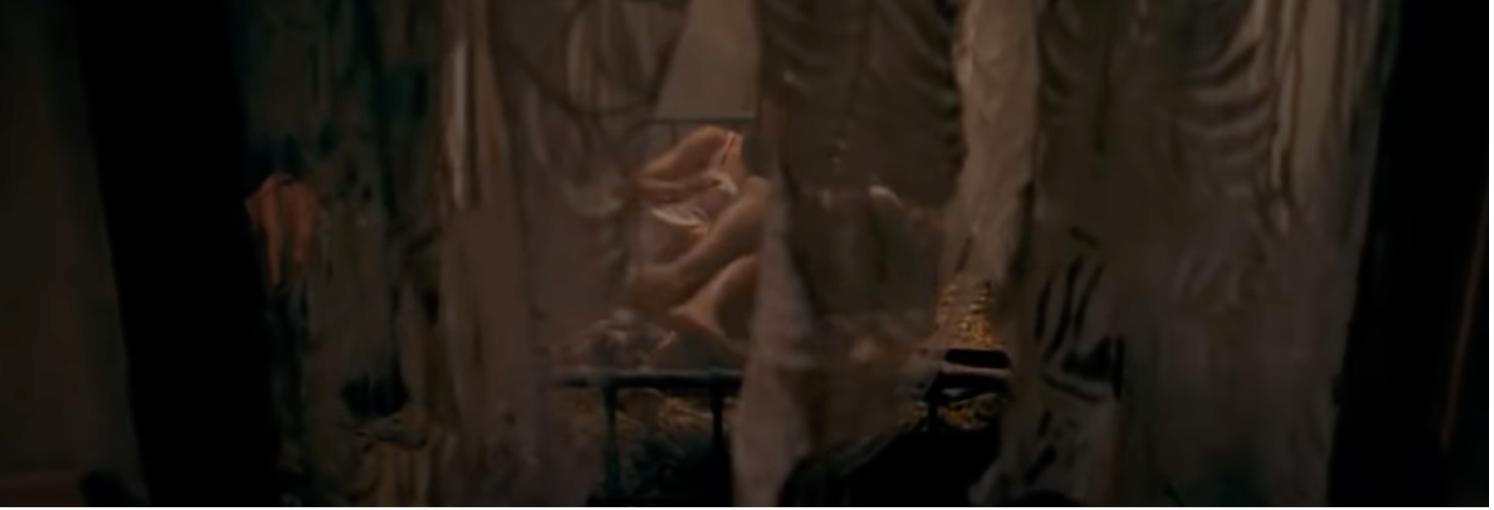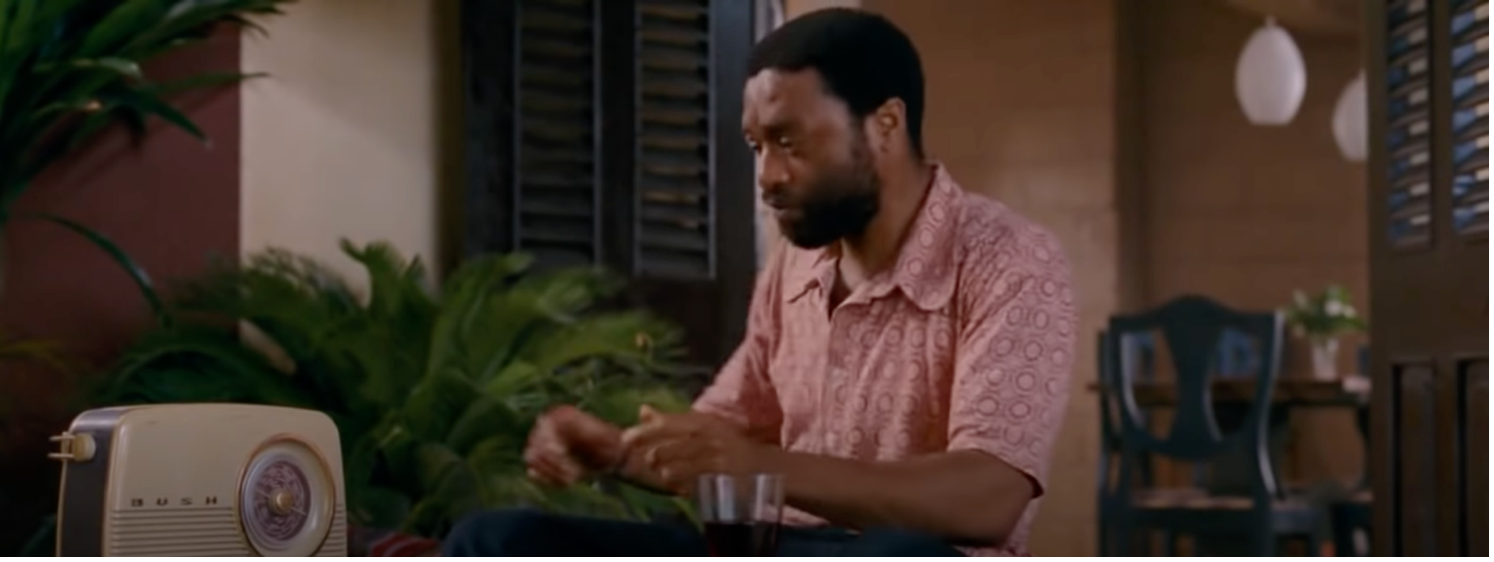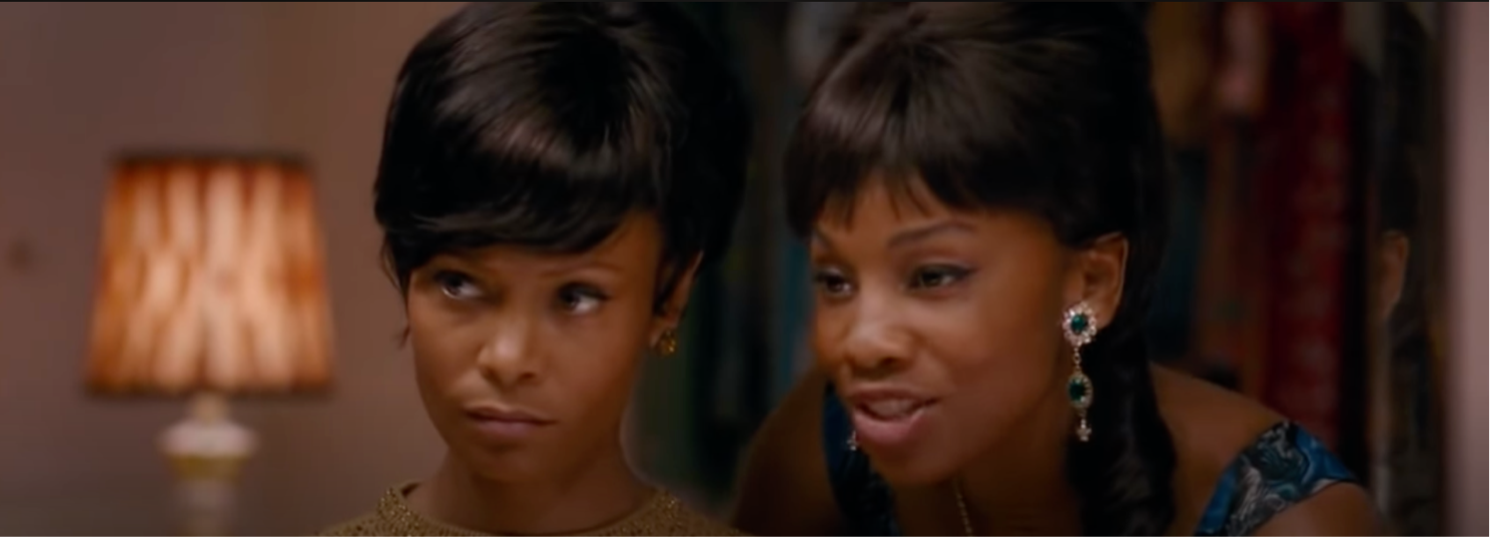From page to screen: between betrayal and re-creation in the film adaptation of Chimamanda Ngozi Adichie’s «Half of a Yellow Sun»
Introduction
“[T]he challenge of being faithful to the source when doing adaptations has not been accomplished in Half of a Yellow Sun” (Villar-Pérez, 2015, 239). When the film Half of a Yellow Sun directed by novelist and playwright Biyi Bandele came out in 2014, critics and scholars almost unanimously agreed: the United-Kingdom-based but Nigerian-born film director failed to successfully adapt Chimamanda Ngozi Adichie’s novel. Published only eight years before, the novel relates the unfolding of the Nigerian civil war – also known as the Biafran war – through the lens of three main characters: the strong-minded Igbo Olanna, the British writer Richard, and the young servant Ugwu. Although the quality of the performances given by the international cast was often praised, several commentators argued that the adaptation did not manage to intermingle the personal and the political as successfully as the source text (see for example Felperin, 2013). Along with Peter Bradshaw who regretted the “very daytime-soapy moments of emotional revelation,” it was generally agreed that the Nollywood production displayed a strong preference for melodrama rather than historical considerations (Bradshaw, 2014; see also Kenigsberg, 2014 and Abele, 2014).
Bandele’s film is obviously not the first adaptation to be criticized for its alleged betrayal of the original text. The censure of the former reader turned spectator has been largely documented in adaptation theory. As Robert Stam reminds us, the adapter always disappoints those reader-spectators attached to the source text:
A ‘faithful’ film is seen as uncreative, but an ‘unfaithful’ film is a shameful betrayal of the original. An adaptation that updates the text for the present is upbraided for not respecting the period of the source, but respectful costume dramas are accused of a failure of nerve in not ‘contemporizing’ the text. If an adaptation renders the sexual passages of the source novel literally, it is accused of vulgarity; if it fails to do so, it is accused of cowardice. The adapter, it seems, can never win. (2005, 8)
The mixed reception of Bandele’s work therefore comes as no surprise. The task of adapting a novel of more than four hundred pages in a film of less than two hours was particularly daunting. Even though the film adaptation could not reasonably retain every detail of the text, some went as far as saying that the novel “could easily have been a mini-series” (Kenigsberg, 2014). Despite the general outcry, the writer of the source text declared that she was quite satisfied with the adaptation (Salt Magazine, 2014). Whether or not Adichie was contractually obliged to express her support is not the point. Instead, it remains to be seen whether the film deserved to be labelled an unfaithful adaptation. Rather than judging the worth of a film adaptation based on its degree of loyalty to the original text, spectators could regard the adaptation as a commentary on the source text and even possibly as an independent work of art. As Brian McFarlane was the first to suggest, the notion of fidelity can – and perhaps should – be abandoned entirely when studying film adaptations: “There are many kinds of relations which may exist between film and literature, and fidelity is only one – and rarely the most exciting” (1996, 11).
This paper will consider whether Bandele’s alleged infidelities allow the reader-spectator to reshape his or her interpretation of the original text. To probe this question, we will first examine what adaptation theory identifies as “quantitative” fidelity and investigate Bandele’s degree of faithfulness as regards the setting, the characters, and the plot, while bearing in mind that a successful adaptation must “use the camera to interpret and not simply illustrate the tale” according to Neil Sinyard (2000, 147). ((“Quantitative” fidelity refers to what is retained from the plot, the characters, the dialogues, or the spatial frame of the original text. “Qualitative” fidelity refers to what the adaptation keeps from the style and the narrative techniques of the original source. The two notions were defined by Laurent Mellet in a conference he gave in January 2021 at the ENS de Lyon on the film adaptation of E. M. Forster’s novel Howards End. Mellet also uses both terms in Mellet, Laurent. “Sense and Sensibility à l’écran : l’adaptation entre explication et consolation.” Cahiers victoriens et édouardiens, no. 82 (November 11, 2015). https://doi.org/10.4000/cve.2361.)) We will then focus on the notion of “qualitative” fidelity and examine if the director manages to capture what Sinyard calls the “spirit of the text” (147). Finally, we will move beyond the notion of faithfulness to study how the film adaptation sends the spectator back to the novel. This will allow us to determine whether Bandele’s adaptation follows Sinyard’s last recommendation: to “exploit a particular affinity between the artistic temperaments and preoccupations of the novelist and filmmaker” (147).
1. Between illustration and interpretation: the film’s quantitative fidelity to the text
Although the first ten minutes of the film depart from the incipit of the source text by concentrating on the introduction of the Nigerian twin sisters Olanna and Kainene rather than on Ugwu’s adaptation to the world of his new master, the university professor Odenigbo, it can be argued that Bandele’s adaptation remains relatively faithful to Adichie’s novel in terms of quantitative fidelity. As George Bluestone states, “changes are inevitable the moment one abandons the linguistic for the visual medium” (1971, 5). Yet, if the plot of Half of a Yellow Sun undergoes major cuts and extensive re-organization, the film rarely takes the liberty of inventing entire scenes out of the blue. Instead, both plot and setting are respected. Given that Adichie’s only requirement was for the film to be shot in Nigeria, this was far from easy (Salt Magazine, 2014). As Raheem Oluwafunminiyi reveals, the adaptation was initially censored in its country of origin by the Nigerian Film and Video Censors Board for fear that its depiction of the Biafran war might resurrect ethnic conflicts (2019, 25-27). At the time of the shooting, the lack of technical structures and the multiplication of government roadblocks engendered major delays in the production while a significant number of the cast and crew fell ill from typhoid and malaria. Despite these varied obstacles, the adaptation still allows the spectator to follow the route taken by the characters of Olanna and Odenigbo – the main couple of the story – as they attempt to escape the conflict. Throughout the film, map outlines and itineraries are repeatedly superimposed over the shots to keep track of the characters’ whereabouts.
As the shots are always organized to draw attention to the map or the itinerary, the spectator is encouraged to acknowledge the importance of space in the Biafran conflict. According to Jeffrey Geiger, this technique “would seem to go against the approach of the novel, which offers no illustrative map, and problematizes the mapped zones of Nigeria and their common territorialisations through a novelistic structure that could be described more as a mosaic than a linear cause and effect pattern” (2018, 68). Nevertheless, Adichie does provide precise spatial indications throughout the novel and Bandele thus follows her example, illustrating through the superimposed maps the traumatic displacement that so many Igbos experienced. This technique may appear outdated but Ben Kenigsberg notes that it is reminiscent of the cinematic aesthetics of the ‘60s (2014), which is the period during which the story unravels.
As regards dialogues and characters, the adaptation maintains strong links with the original text. If some characters are completely erased to avoid complicated subplots – for instance, the secondary love interests of the main protagonists (Mohammed, Madu and Alice) are never once mentioned – none are added. However, the film was often condemned for some of its casting choices. Choosing Thandiwe Newton – a British actress of Zimbabwean descent with no connection to Nigeria – to play the role of the Igbo Olanna was sometimes seen as an example of cultural misrepresentation given the actress’s light skin and her difficulty pronouncing certain Igbo words (Amah, 2020, 77). A petition was even launched against her casting as soon as it was announced. ((The petition notably stated that "Thandie Newton is an accomplished and talented actress in her own right. However, she is not Igbo, she is not Nigerian, and she does not physically resemble Igbo women in the slightest." It can still be found here: https://www.change.org/p/the-casting-of-thandie-newton-in-half-of-a-yellow-sun-reconsider-casting-of-half-of-a-yellow-sun.)) Hiring an internationally recognized cast was a way to “confirm Nollywood had finally graduated to an international stage, achieving long-sought-after mainstream respectability” (Geiger, 2018, 60-61). Financial concerns can also explain this casting choice. Quoting the executive producer of the film, Yewande Sadiku, who declared that “with the sort of budget we had for Half of a Yellow Sun, we knew we could not get those returns if we focused entirely just in the African continent or just the audience that consumes Nollywood films,” Raquel Villar-Pérez remarks that the film was the most expensive Nollywood production at the time and had to rely on British and American actors and actresses to attract Western audiences (2015, 237). Nonetheless, it can be argued that this problematic westernization somewhat respects the characterization of Olanna in Adichie’s novel. As Munachim Amah asserts, the novel often stresses the cosmopolitanism of the twin sisters: “Olanna and her sister Kainene are symbols of change, underlining how Igbo people who left the region at that time returned changed, different, with new values and languages and identities, upturning the status quo” (2020, 82). As she studied sociology in London, Olanna stands apart in the Igbo community and Miss Adebayo – Odenigbo’s Yoruba friend whom Olanna meets upon moving in with Odenigbo in Nsukka – even criticizes her “mimicking-the-oppressor English accent” (Adichie, 2017, 51). On both screen and page, Olanna’s modernity is constantly accentuated. When Odenigbo’s mother accuses her of witchcraft towards the beginning of the novel, the film almost keeps the tense exchange that follows in its entirety. In addition, Bandele makes judicious use of the shot/reverse-shot technique to display the discrepancy between the two women, and Olanna is progressively left alone in the medium close-ups that focus on her as Mama disappears from the frame.
Later on, the gap between the villager and the modern woman keeps widening. In the novel, Odenigbo excuses his mother’s behavior on account of her traditionalism: “She’s trying to make her way in a new world with skills that are better suited for the old one” (100). Even though the adaptation cuts this line, a series of medium shots and medium close-ups repeatedly present Olanna conversing with Odenigbo in front of the kitchen stove, the very kitchen stove that was previously dismissed by Mama as a waste of money. In these examples, the camera goes beyond the simple illustration: the cinematic techniques hint at the impossible reconciliation between the traditional older mother and the younger West-educated woman. Although the text acknowledges this disjunction, the adaptation reinforces it visually. As a consequence, Bandele’s film makes the most of a casting choice that may have been imposed by the film studio.
Furthermore, Bandele’s adaptation also achieves quantitative fidelity in its depiction of the Nigerian civil war. Just as the four-part structure of the novel suggests how the conflict intruded on the characters’ privacy by maintaining a back-and-forth movement between personal drama in the early ‘60s and the unraveling of the war in the late ‘60s, the three bombing scenes of the film highlight how the Biafran war keeps interrupting individual lives, even if Bandele drops the four-part structure. When Adichie describes the first bombing which occurs in Olanna and Odenigbo’s home in Nsukka, Ugwu almost does not hear the bombs as he is too captivated by Olanna’s account of a childhood memory: “[Ugwu] was absorbed in Olanna’s voice and so he did not hear the sound – boom-boom-boom – from somewhere distant outside the windows, until she stopped stirring and looked up” (178). On the screen, the conversation between the two characters disappears but the same effect is achieved. The camera is placed outside the walls of the living-room and the figure of Olanna cooking in the kitchen can only be guessed in the background, behind closed windows.
The format of the long shot is kept throughout the scene and the travelling of the camera follows the characters from afar as they move from room to room and hurriedly prepare to leave their home. The spectator becomes a voyeur who is made privy to the characters’ first experience of displacement. As the noises of the bombs are heard in the distance, the director underlines how war looms in the background and brings the innocence of everyday life to an end.
Similarly, the second bombing scene which happens during Olanna and Odenigbo’s wedding stresses once again how the war disturbs personal lives. Whereas the characters are said to be dancing outside before the plane strikes in Adichie’s novel, Bandele situates them inside (202). The spectator is assimilated to wedding guests as the camera is placed in the same room as the characters when the bomb explodes in the background, behind the window.
The shock of the explosion is only reinforced by the impossibility of escape, and the following medium close-up plunges the spectator into the disarray of the characters. The last bombing scene – which takes place at a refugee camp – relies on the same process. Whereas Olanna sleeps outside the shelter in Adichie’s novel (385), she is shown inside with Odenigbo when the camp is bombed in Bandele’s adaptation. As the camera moves through the ragged curtains of the window, the audience understands that war destroys any sense of privacy.
In terms of setting, plot, and characters, the adaptation remains quite faithful to the original text and the rare liberties that are taken often reflect an attempt to interpret the novel rather than illustrate it. The adaptation thus avoids the risk of being a mere copy of the original material. In spite of these occasional infidelities, Bandele might still be able to translate the “spirit of the text” as recommended by Neil Sinyard.
2. Adapting Adichie’s style: qualitative fidelity and the “spirit of the text”
We may argue that Bandele’s depiction of the civil war gives priority to violence rather than trauma. For instance, the scene of the Kano airport massacre is extended to heighten the brutality of the conflict. In the novel, the passage is already stirring but remains quite short – only half a page is dedicated to this horrendous description through the focalization of Richard (153). On the screen, Bandele decides to prolong the massacre: four Igbos are shot at point blank and the camera later adopts a high angle – symbolizing the fact that the scene is seen through Richard’s eyes – to focus on the Igbo passengers that are executed one by one.
In addition, Bandele includes a second scene of massacre which tends to dramatize the war. In the novel, Olanna does not bear witness to her aunt’s massacre as she arrives too late. Instead, she discovers the bodies of her relatives: “She stopped when she saw the bodies. Uncle Mbaezi lay face down in an ungainly twist, legs splayed. Something creamy-white oozed through the large gash on the back of his head. Aunty Ifeka lay on the veranda. The cuts on her naked body were smaller, dotting her arms and legs like slightly parted red lips.” (147). In this example, Olanna’s focalization conveys how people who experience intense shocks usually react. The meticulous precision of the bodies’ positions appears to indicate that the character was so struck by this horrendous vision that she can describe it precisely. As for the disturbing final simile, it shows how traumatized people often attempt to make sense of the unthinkable by using relatable images. Olanna almost sounds detached from the scene, which is also a traditional defense mechanism among traumatized victims. On the other hand, the film invents a harrowing scene in which the character sees her aunt being dragged by an enemy soldier holding a machete, leaving no doubt as to what is about to happen. The spectator no longer reads about the dreadful consequences of the massacre but witnesses Olanna’s helplessness and is left to imagine how Aunty Ifeka will die. Because the audience is likely to identify with Olanna’s frustration, this modification slightly sensationalizes Adichie’s representation of the conflict by emphasizing the event rather than the trauma that follows it. Finally, in the novel, it is Dr Nwala who tells Olanna about the death of Odenigbo’s friend, the poet Okeoma – “Okeoma has gone, o jebego” (391). In the film, the two lovers are turned into bystanders when the poet is hit by a bomb during their wedding. The use of a close-up emphasizes Odenigbo’s speechlessness.
Again, as the screen progressively fades to black, the reader-spectator understands that the director has decided to visually represent the horrors of war but not to dwell on the traumatic effects of the massacres. The discrepancy between how Bandele and Adichie deal with Olanna’s difficult recovery from the slaughter of her family corroborates this interpretation. Adichie almost dedicates an entire chapter to her difficult healing whereas Bandele merely alludes to it – we see Olanna as she is confined to her bed and struggles to walk, before the film focuses on the second couple of the story, Richard and Kainene (157-163). By adopting a different approach to the depiction of the conflict, Bandele seems to betray the spirit of the novel. Yet the director still manages to expose the national taboo surrounding the Biafran war. This exposure is already present in Adichie’s novel, but as Chibundu Onuzo reminds us, when the film was released, history had been removed from the standard secondary school curriculum in Nigeria (Onuzo, 2014). In this context of national myopia, confronting the Nigerian spectator more directly with the bloodshed allows Bandele to adapt Adichie’s reflection on the evolving political landscape, thus navigating between faithfulness and unfaithfulness.
Answering the writer’s call to engage with history, Bandele’s adaptation sometimes resembles a documentary film. Throughout her novel, Adichie achieves a sense of historical authenticity by reproducing extracts from authentic speeches given by key figures of the conflict. For example, when the January coup of 1966 is announced, Chukwuma “Kaduna” Nzeogwu’s radiophonic speech is presented without any verb of introduction or punctuation mark aside from the use of italics: “The voice on the radio was youthful, eager, confident. The Constitution is suspended and the regional government and elected assemblies are hereby dissolved …” (123). As a nod to the novel, radiophonic speeches are included in the film and their historical value is underscored – the radio is repeatedly seen in the left corner of the shot, in the foreground.
The information given as regards the future of the characters at the end of the film as well as the multiplication of historical television news clips about the civil war only accentuate the impression that Bandele’s film is not entirely fictional. However, just as Adichie selects specific extracts of the speeches she reproduces on the page, Bandele’s choice of archival documents is not a mere coincidence: the news clip that follows the announcement of the coup focuses on its failures. Combined with the ominous melody that is heard in the next scene, the spectator comes to realize that Odenigbo and his friends claimed victory too early.
Right from the beginning, Bandele announces the constant intermingling of fiction and history. After showing an authentic television news clip about the official visit of Elizabeth II to the newly independent Nigeria in 1960, the camera reveals a close-up of an imposing mirror ball which swirls against a dark background. The ceremonial music of the news clip is soon replaced by Miriam Makeba’s joyful “Naughty Little Flea.” The sharp contrast between the first clip and the following shot illustrates the transition from the rigidity of colonial rule to the euphoria engendered by the promise of an emergent democratic society. It also foreshadows that the film will alternate between political events and individual joys, between history and fiction. Regardless of this apparent closeness between the source text and its adaptation, it is precisely the imbalance between history and fiction that critics often regretted in Bandele’s adaptation. Considering the pictures they chose for their reviews, critics seemed to agree that the film was first and foremost a love story – many of them decided to include only pictures of Olanna and Odenigbo in their papers (see Bradshaw, 2014 and Kenigsberg, 2014). The poster chosen for the DVD cover confirms this hypothesis: showing the two main couples of the story, it minimizes the importance of the historical context which is alluded to through shadowy figures, presented at the very bottom of the poster.
Adichie herself stated that she wanted “to write about love and war” (Oluwafunminiyi, 2019, 18, emphasis mine). Yet, the first fifty-three minutes of the film enhance the romance and considerably de-politicize the content of the first and third parts of the book. The first chapter of the novel insists on the revolutionary content of Odenigbo’s soirées, an enumeration informing us that he and his guests discuss a variety of topical issues: “the world had to do more about the black people killed in Sharpeville, that the spy plane shot down in Russia served the Americans right, that De Gaulle was being clumsy in Algeria, that the United Nations would never get rid of Tshombe in Katanga” (17). In the adaptation, these conversations are mostly cleared of their political aspect. The spectator must wait until the second half of the film to delve into the complexities of the Biafran conflict, a transition announced by the introduction of another news clip explaining how the first riots erupted. According to Jude Akudinobi, the two-part structure of the film engenders the same effect as the four-part structure of the book: “The intertwining connections between the two parts create a structure that underscores the poignant personal, familial, political, and national saga” (2015, 279). Nevertheless, the bridge between personal and national drama can be perceived as artificial and incoherent. In this perspective, the war becomes a pretext, a mere backdrop to the unfolding of personal drama, and Bandele’s adaptation could be regarded as unfaithful to the “spirit of the text.” Even so, some of the best adaptations are often accused of the same flaw. Moving beyond the notion of faithfulness will help us examine how the adaptation might shape a potential re-reading of the novel.
3. Beyond faithfulness: from the film back to the novel
Putting aside any reservations we might have in terms of faithfulness allows us to reconsider some of the artistic choices made by the director, notably his preference for a chronological narrative. According to Raquel Villar-Pérez, Bandele acknowledged that, after three years of working on the script, he still did not like Adichie’s flashback/flashforward structure and consequently decided to alter this fragmented chronology (2015, 238). This radical modification could easily be identified as another departure from the source text, but as we pointed out, this linearity does not prevent Bandele’s camera from highlighting how the personal and the political merge in Half of a Yellow Sun. In addition, replacing the four-part structure with a two-part structure heightens the quickness of the transition between peace and war time. When the television news clip announces the first riots, the rhythm of the film accelerates, and the reader-spectator is inclined to perceive a shift in tone. To signal this disruption, the Kano airport scene is partly rewritten to prioritize the unfolding of the war. At first sight, the scene gives prominence to melodrama: Richard and Olanna briefly meet at the airport after the revelation of their affair and the travelling technique gives us a taste of the dramatic tension between the two characters. Nonetheless, the shooting soon interrupts these furtive glances, hence suggesting that the film will no longer focus on the personal. Whereas only two television news clips were introduced in the first part of the film, their number doubles in the second part and the war can no longer be ignored. The voice-over even disappears in the last of these clips which show how decimated the Igbo population was after the end of the Biafran conflict. The transition from black-and-white to color in these last clips could be seen as a reminder that the war should not be associated with the past only. Instead, its consequences still resonate in modern-day Nigeria. This is Chibundu Onuzo’s preferred interpretation when she stresses the importance of Bandele’s adaptation in her home country: “It is important that we look back, if only to say that we have not moved forward. It is important that contesting accounts of our past be brought out into the public space. We must remember and we must do it together” (2014).
Moreover, what is perhaps most striking about Bandele’s adaptation is how two main characters are relegated to the sidelines – namely the British writer Richard and the houseboy Ugwu. According to Kamilla Elliot, this type of apparent unfaithfulness often originates from the source text itself:
What one discovers is that many so-called ‘unfaithful’ adaptations are operating under a de(re)composing model. They are condemned as unfaithful because critics read only one way from novel to film and find that the film has made changes. But if one reads in both directions from novel to film and then from film back to novel one often finds the alleged infidelities clearly in the text. These ‘infidelities’ represent rejections of certain parts of the novel in favor of others, not total departures from the novel. (2003, 157)
Following Elliott’s advice, we will resist the temptation of adding the characters’ dismissal to the list of Bandele’s “infidelities” and analyze how this alteration invites us to go back to the text. Throughout the film, Ugwu is downgraded to the role of supporting character, only appearing on screen after thirteen minutes whereas the incipit of the novel is focalized through his perspective (3-25). Later in the film, the houseboy is literally invisible on the screen as he offers Olanna some food. Additionally, the spectator is never given a glimpse of his experience in the military when he is enlisted by force. Ugwu’s disappearance is not insignificant and may be a way for Bandele to continue Adichie’s historiographical reflection. In establishing Ugwu as one of the main protagonists and as the rightful author of the book The World Was Silent When We Died – of which the reader is given a few summaries throughout the novel – the novelist argues that the history of the Biafran war should be told by the subaltern, hence answering Gayatri C. Spivak’s famous question “Can the Subaltern Speak?” favorably (see Morris & Spivak, 2010). The writer’s insistence on the legitimacy of the houseboy recalls Robert Holton’s emphasis on the need for the “jarring witnesses” of history to make their voices heard (see Holton, 1994). Under Elliott’s “de(re)composing model,” Ugwu’s noticeable absence on the screen might echo this historiographical debate by titillating the reader-spectator’s urge to know more about the character. It is perhaps precisely because the spectator cannot miss the character’s almost total disappearance that the director successfully magnifies his importance. This presence-absence warns the spectator against any historical account of the civil war that would overlook the testimony of the forgotten actors of the conflict. Concurrently, the minor role of Richard could indicate that if the subaltern cannot speak, the white colonizer should not speak either. This interpretation encourages the spectator to go back to the novel and pay more attention to what Ugwu can tell us about his experience. Nonetheless, by erasing both Ugwu and Richard’s perspectives from the narrative, Bandele runs the risk of presenting a “single story,” of relating the Biafran war from a monolithic perspective, a danger which Adichie already addressed in her famous 2014 TED talk.
Right from the beginning, Bandele gives preference to the female perspective. Kainene and mostly Olanna are given center stage throughout the film and Adichie’s incipit is replaced by the business dinner in which Chief Ozobia attempts to trade sexual favors from his daughter for the acquisition of a contract. Jude Akudinobi praises this feminization of the war narrative, arguing that the variety of contexts in which women are portrayed in the film allows for a multi-faceted representation of African femininity: “Whereas war narratives often privilege aggressive, ‘heroic’ masculinities, women are key protagonists here. Though they are portrayed largely in the contexts of home, family, romance, marriage, and maternity, the film depicts varied configurations of African femininity” (2015, 280). Through his focus on the Nigerian sisters, Bandele mirrors Adichie’s desire to challenge the traditional representation of African women. Interestingly, however, the director disregards the growing estrangement between the two sisters that Olanna reflects upon in the first chapter of the novel: “It was now that they were back from England, living in the same house again, that Olanna realized just how distant they had become” (36). By reversing the chronology of the business dinner and introducing the private conversation between the two sisters first, the adaptation suggests a form of solidarity between Olanna and Kainene. As a medium close-up reveals Kainene’s facetiousness when she asks her sister: “Will you be spreading your legs for the right honorable minister?”, the spectator is given a glimpse at their intimate relationship.
When they later put up a united front and cut short the business dinner on the pretext of joining the independence celebrations together, Kainene and Olanna are again portrayed as quite close. Behind this emphasis on sisterhood and female solidarity, we might recognize what Dennis Cutchins refers to as a form of “perceived intentionality” (2017, 84). The demotion of two major male characters as well as the importance given to the confidential relationship between the twin sisters cannot be explained by the passage from the written to the visual medium. On the contrary, Bandele makes an artistic decision and perhaps invites us to reread the novel more critically when it comes to the initial lack of solidarity between Olanna and Kainene.
Conclusion
This article has attempted to show that critics and scholars who reproached Bandele’s adaptation for its lack of faithfulness were probably too hasty. Despite the threat of censorship and the technical difficulties of shooting a film of this scale in Nigeria, the adaptation mostly defies the accusation of betrayal in terms of quantitative fidelity as it takes very few liberties as regards the source text. If the camera does not simply illustrate the tale, it remains problematic that the rare liberties that are taken – such as the return to a chronological narrative or the silencing of the polyphonic narrative – almost always betray Adichie’s elements of style. As a consequence, Bandele’s film never falls under the category of the “curatorial adaptations,” defined by Thomas Leitch as a type of adaptation which praises the qualities of the original source (2007, 93-126). In other words, the adaptation neither glorifies nor celebrates the novelist’s style and Bandele shows almost no interest in transposing the main stylistic qualities of the source text. As he decides to concentrate the first half of the film solely on the romance, the novelist’s absolute refusal to “romanticize the war” goes unheard and the transition to the war narrative is perhaps a little contrived (Adichie, 2008, 50). This is not to say that the director fails to lift the veil on the national taboo surrounding the Biafran war. On the contrary, Bandele firmly sides with Adichie on the necessity to explore this traumatic history. The director and the novelist do share the “particular affinity” in preoccupations that Neil Sinyard recognized as one of the three criteria for a successful adaptation without always having the same “artistic temperaments” (2000, 147). Even though the director seemed satisfied to hear from the spectators that the film reminded them of the nastiness of war, Adichie’s novel goes further than this simple reminder (Bandele, 2014). Whereas Half of a Yellow Sun offers the reader an in-depth reflection on historiography, Bandele’s adaptation only touches upon the subject, even when it manages to send the spectator back to the novel. On the one hand, when the notion of faithfulness guides our analysis, the film does not entirely convey Adichie’s style. On the other, if we consider adaptations as complete re-creations, the film appears to take few liberties. But in choosing the middle way, Bandele makes use of his interpretive license and offers some guidelines for a potential re-reading of the text. As Ben Kenigsberg reminds us, this was not an easy task as “the greatest challenge faced by literary adaptations that juxtapose a small group of characters against a seismic backdrop – “Doctor Zhivago,” say, or “The Leopard” – is one of proportion” (2014). The multi-layered density of Adichie’s work does not lend itself easily to a change of medium. Yet, Bandele rose to the challenge and managed to turn a novel that “could easily have been a mini-series” according to Kenigsberg’s suggestion into a film adaptation which successfully questions our initial reading of the source text.
Notes
Bibliography
ABELE, Robert. « Review: Half of a Yellow Sun Doesn’t Add Up to a Satisfying Whole », Los Angeles Times, 23 May 2014, https://www.latimes.com/entertainment/movies/la-et-mn-half-yellow-sun-review-20140523-story.html.
ADICHIE, Chimamanda Ngozi. 2008. « African ‘Authenticity’ and the Biafran Experience », Transition, volume 99, pp.42–53.
———. 2009. Chimamanda Ngozi Adichie: The Danger of a Single Story. TED Talk, 18 minutes,
https://www.ted.com/talks/chimamanda_ngozi_adichie_the_danger_of_a_single_story.
———. 2017 (2006). Half of a Yellow Sun. London: 4th Estate.
AKUDINOBI, Jude G. 2015. « Film Reviews: Half of a Yellow Sun », African Studies Review, volume 58, n° 2, pp.279–81, https://doi.org/10.1017/asr.2015.62.
AMAH, Munachim. 2020. « Portrayal of Igbo Culture in the Film Adaptations of Things Fall Apart and Half of a Yellow Sun », Critical Arts: A South-North Journal of Cultural & Media Studies, volume 34, n° 4, pp.76-89, https://doi.org/10.1080/02560046.2020.1726980.
BANDELE, Biyi. « Why Can’t Nigerians See Half of a Yellow Sun? By Biyi Bandele », Premium Times Nigeria, 23 May 2014, https://www.premiumtimesng.com/opinion/161373-cant-nigerians-see-half-yellow-sun-biyi-bandele.html.
———, director. Half of a Yellow Sun. Monterey Media, 2014, 111 minutes.
BLUESTONE, George. 1971 (1951). Novels into Film. Berkeley: University of California Press.
BRADSHAW, Peter. « Half of a Yellow Sun Review – ‘Well-Intentioned and Heartfelt », The Guardian, 10 April 2014, https://www.theguardian.com/film/2014/apr/10/half-of-a-yellow-sun-chimamanda-ngozi-adichie-film-review.
ELLIOTT, Kamilla. 2003. Rethinking the Novel/Film Debate. Cambridge: Cambridge University Press.
FELPERIN, Leslie. « Half of a Yellow Sun: London Review », The Hollywood Reporter, 11 October 2013, https://www.hollywoodreporter.com/movies/movie-news/a-yellow-sun-london-review-647828/.
GEIGER, Jeffrey. 2018. « Media Refashioning: From Nollywood to New Nollywood » in Rob Stone, Paul Cooke et al., The Routledge Companion to World Cinema. London and New York: Routledge, pp.59-72.
HOLTON, Robert. 1994. Jarring Witnesses. Modern Fiction and the Representation of History. New York: Harvester Wheatsheaf.
KENIGSBERG, Ben. « In Nigeria, the Personal and the Political Clash », The New York Times, 15 May 2014, https://www.nytimes.com/2014/05/16/movies/chiwetel-ejiofor-stars-in-half-of-a-yellow-sun.html.
LEITCH, Thomas. 2007. Film Adaptation and Its Discontents. Baltimore: Johns Hopkins University Press.
——— (ed.). 2017. The Oxford Handbook of Adaptation Studies. Oxford: Oxford University Press.
McFARLANE, Brian. 1996. Novel to Film: An Introduction to the Theory of Adaptation. Oxford: Clarendon.
MELLET, Laurent. 2015. « Sense and Sensibility à l’écran : l’adaptation entre explication et consolation. », Cahiers victoriens et édouardiens, n° 82, https://doi.org/10.4000/cve.2361.
MORRIS, Rosalind C., and SPIVAK, Gayatri Chakravorty (eds.). 2010. Can the Subaltern Speak?: Reflections on the History of an Idea. New York: Columbia University Press.
OLUWAFUNMINIYI, Raheem. 2019. « Beyond Censorship: Contestation in Half of a Yellow Sun’s Cinematic Adaptation », New Trends in Social and Liberal Sciences, volume 4, n° 1, pp.16–35, https://doi.org/10.24819/netsol2019.02.
ONUZO, Chibundu. « Nigeria’s History Problem Needs the Light from Half of a Yellow Sun », The Guardian, 15 April 2014, https://www.theguardian.com/commentisfree/2014/apr/15/nigeria-history-half-yellow-sun-civil-war-biyi-bandele.
SALT MAGAZINE. « Chimamanda Ngozi Adichie », 26 February 2014, http://www.saltmagazine.org/chimamanda-ngozi-adichie/.
SINYARD, Neil. 2000. « ‘Lids tend to come off’: David Lean’s Film of E. M. Forster’s A Passage to India », in Erica Sheen et Robert Giddings, The Classic Novel. From Page to Screen. Manchester: Manchester University Press, pp.147.
STAM, Robert, and RAENGO Alessandra (eds.). 2005. Literature and Film: A Guide to the Theory and Practice of Film Adaptation. Oxford: Blackwell.
VARIETY. « Yellow Sun Rises in West Africa”, 28 July 2012, https://variety.com/2012/film/news/yellow-sun-rises-in-west-africa-1118057146/.
VILLAR-PÉREZ, Raquel. 2015. « Half of a Yellow Sun », Journal of African Media Studies, volume 7, n° 2, pp.237–40, https://doi.org/10.1386/jams.7.2.237_5
Pour citer cette ressource :
Agathe Faucourt, From page to screen: between betrayal and re-creation in the film adaptation of Chimamanda Ngozi Adichie’s Half of a Yellow Sun, La Clé des Langues [en ligne], Lyon, ENS de LYON/DGESCO (ISSN 2107-7029), avril 2023. Consulté le 28/12/2025. URL: https://cle.ens-lyon.fr/anglais/arts/cinema/from-page-to-screen-chimamanda-ngozi-adichies-half-of-a-yellow-sun



 Activer le mode zen
Activer le mode zen